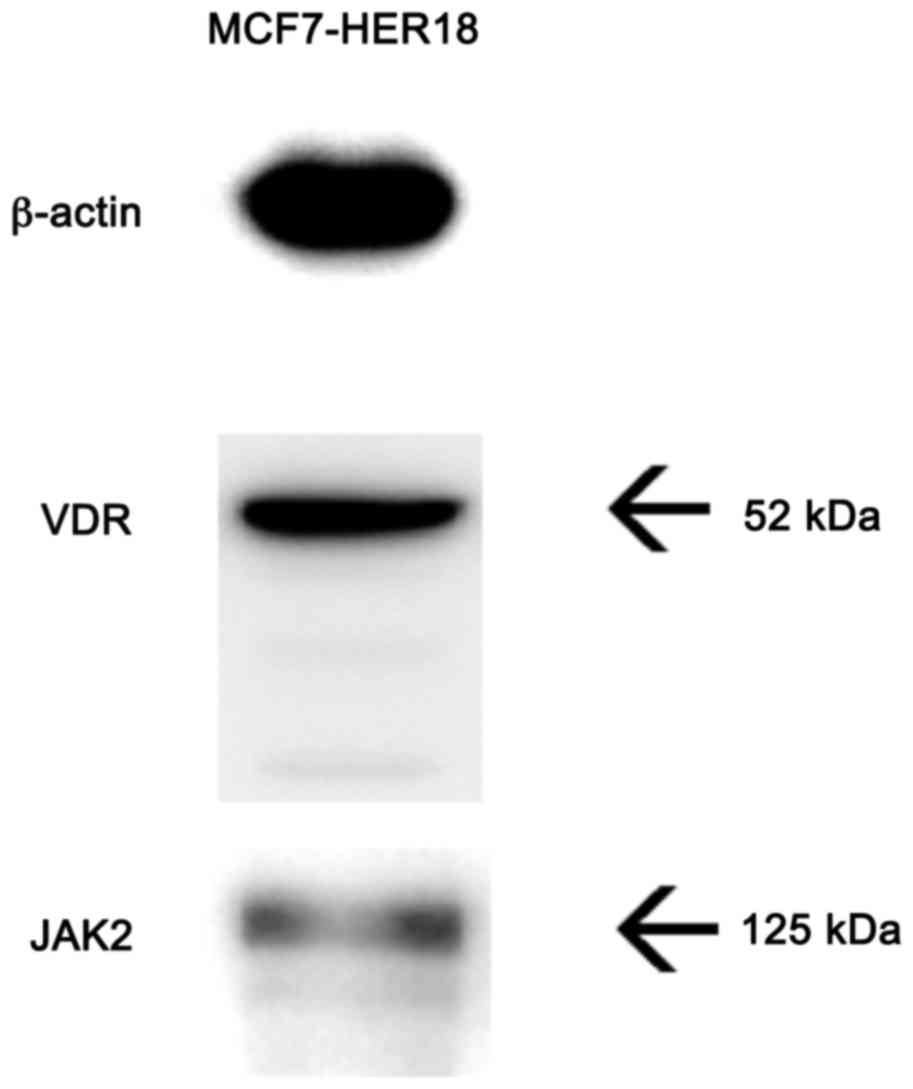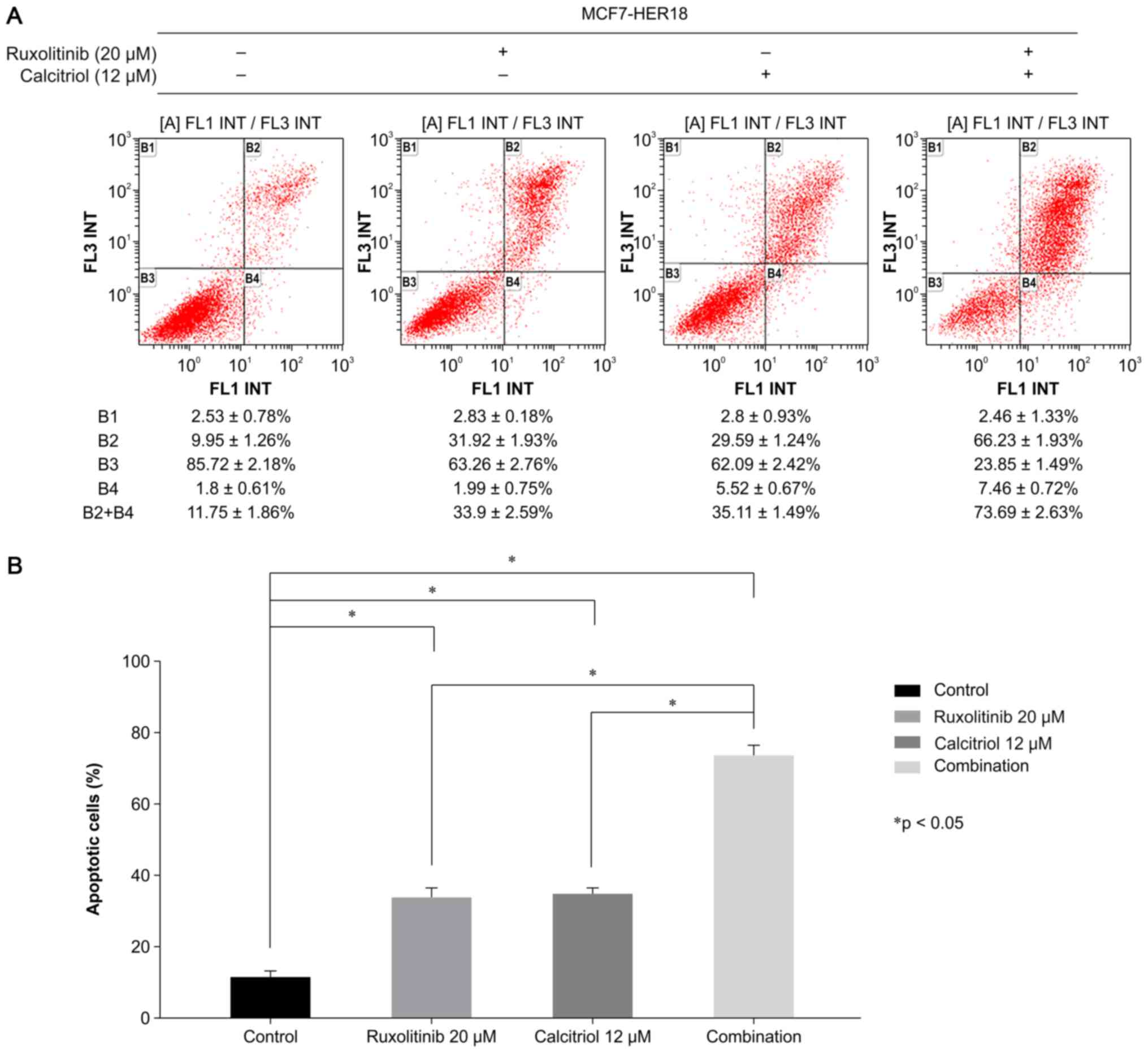|
1
|
Siegel RL, Miller KD and Jemal A: Cancer
statistics, 2016. CA Cancer J Clin. 66:7–30. 2016. View Article : Google Scholar : PubMed/NCBI
|
|
2
|
Sorlie T, Tibshirani R, Parker J, Hastie
T, Marron JS, Nobel A, Deng S, Johnsen H, Pesich R, Geisler S, et
al: Repeated observation of breast tumor subtypes in independent
gene expression data sets. Proc Natl Acad Sci USA. 100:pp.
8418–8423. 2003; View Article : Google Scholar : PubMed/NCBI
|
|
3
|
Goldhirsch A, Winer EP, Coates AS, Gelber
RD, Piccart-Gebhart M, Thürlimann B and Senn HJ; Panel members, :
Personalizing the treatment of women with early breast cancer:
Highlights of the St Gallen International Expert Consensus on the
Primary Therapy of Early Breast Cancer 2013. Ann Oncol.
24:2206–2223. 2013. View Article : Google Scholar : PubMed/NCBI
|
|
4
|
Russnes HG, Lingjærde OC, Børresen-Dale AL
and Caldas C: Breast cancer molecular stratification: From
intrinsic subtypes to integrative clusters. Am J Pathol.
187:2152–2162. 2017. View Article : Google Scholar : PubMed/NCBI
|
|
5
|
Voduc KD, Cheang MC, Tyldesley S, Gelmon
K, Nielsen TO and Kennecke H: Breast cancer subtypes and the risk
of local and regional relapse. J Clin Oncol. 28:1684–1691. 2010.
View Article : Google Scholar : PubMed/NCBI
|
|
6
|
Tran B and Bedard PL: Luminal-B breast
cancer and novel therapeutic targets. Breast Cancer Res.
13:2212011. View
Article : Google Scholar : PubMed/NCBI
|
|
7
|
Yoo C, Ahn JH, Jung KH, Kim SB, Kim HH,
Shin HJ, Ahn SH, Son BH and Gong G: Impact of
immunohistochemistry-based molecular subtype on chemosensitivity
and survival in patients with breast cancer following neoadjuvant
chemotherapy. J Breast Cancer. 15:203–210. 2012. View Article : Google Scholar : PubMed/NCBI
|
|
8
|
Liedtke C, Packeisen J, Hess KR, Vogt U,
Kiesel L, Kersting C, Korsching E, Brandt B and Buerger H:
Systematic analysis of in vitro chemosensitivity and mib-1
expression in molecular breast cancer subtypes. Eur J Cancer.
48:2066–2074. 2012. View Article : Google Scholar : PubMed/NCBI
|
|
9
|
Valabrega G, Montemurro F, Sarotto I,
Petrelli A, Rubini P, Tacchetti C, Aglietta M, Comoglio PM and
Giordano S: TGFalpha expression impairs trastuzumab-induced HER2
downregulation. Oncogene. 24:3002–3010. 2005. View Article : Google Scholar : PubMed/NCBI
|
|
10
|
Wilks ST: Potential of overcoming
resistance to HER2-targeted therapies through the PI3K/Akt/mTOR
pathway. Breast. 24:548–555. 2015. View Article : Google Scholar : PubMed/NCBI
|
|
11
|
Sai K, Wang S, Balasubramaniyan V, Conrad
C, Lang FF, Aldape K, Szymanski S, Fokt I, Dasgupta A, Madden T, et
al: Induction of cell-cycle arrest and apoptosis in glioblastoma
stem-like cells by WP1193, a novel small molecule inhibitor of the
JAK2/STAT3 pathway. J Neurooncol. 107:487–501. 2012. View Article : Google Scholar : PubMed/NCBI
|
|
12
|
Thomas SJ, Snowden JA, Zeidler MP and
Danson SJ: The role of JAK/STAT signaling in the pathogenesis,
prognosis and treatment of solid tumours. Br J Cancer. 113:365–371.
2015. View Article : Google Scholar : PubMed/NCBI
|
|
13
|
Khanna P, Chua PJ, Bay BH and Baeg GH: The
JAK/STAT signaling cascade in gastric carcinoma (Review). Int J
Oncol. 47:1617–1626. 2015. View Article : Google Scholar : PubMed/NCBI
|
|
14
|
Verstovsek S, Mesa RA, Gotlib J, Levy RS,
Gupta V, DiPersio JF, Catalano JV, Deininger M, Miller C, Silver
RT, et al: A double-blind, placebo-controlled trial of ruxolitinib
for myelofibrosis. N Engl J Med. 366:799–807. 2012. View Article : Google Scholar : PubMed/NCBI
|
|
15
|
Vannucchi AM, Kiladjian JJ, Griesshammer
M, Masszi T, Durrant S, Passamonti F, Harrison CN, Pane F, Zachee
P, Mesa R, et al: Ruxolitinib versus standard therapy for the
treatment of polycythemia vera. N Engl J Med. 372:426–435. 2015.
View Article : Google Scholar : PubMed/NCBI
|
|
16
|
Tavallai M, Booth L, Roberts JL, McGuire
WP, Poklepovic A and Dent P: Ruxolitinib synergizes with DMF to
kill via BIM+BAD-induced mitochondrial dysfunction and via reduced
SOD2/TRX expression and ROS. Oncotarget. 7:17290–17300. 2016.
View Article : Google Scholar : PubMed/NCBI
|
|
17
|
Tavallai M, Booth L, Roberts JL,
Poklepovic A and Dent P: Rationally repurposing ruxolitinib (Jakafi
(®)) as a solid tumor therapeutic. Front Oncol.
6:1422016. View Article : Google Scholar : PubMed/NCBI
|
|
18
|
Lee HJ, Seo NJ, Jeong SJ, Park Y, Jung DB,
Koh W, Lee HJ, Lee EO, Ahn KS, Ahn KS, et al: Oral administration
of penta-O-galloyl-β-D-glucose suppresses triple-negative breast
cancer xenograft growth and metastasis in strong association with
JAK1-STAT3 inhibition. Carcinogenesis. 32:804–811. 2011. View Article : Google Scholar : PubMed/NCBI
|
|
19
|
Lange TS, Singh RK, Kim KK, Zou Y,
Kalkunte SS, Sholler GL, Swamy N and Brard L: Anti-proliferative
and pro-apoptotic properties of 3-bromoacetoxy calcidiol in
high-risk neuroblastoma. Chem Biol Drug Des. 70:302–310. 2007.
View Article : Google Scholar : PubMed/NCBI
|
|
20
|
Rashid SF, Moore JS, Walker E, Driver PM,
Engel J, Edwards CE, Brown G, Uskokovic MR and Campbell MJ:
Synergistic growth inhibition of prostate cancer cells by 1
alpha,25 dihydroxyvitamin D(3) and its 19-nor-hexafluoride analogs
in combination with either sodium butyrate or trichostatin A.
Oncogene. 20:1860–1872. 2001. View Article : Google Scholar : PubMed/NCBI
|
|
21
|
Yao S, Kwan ML, Ergas IJ, Roh JM, Cheng
TD, Hong CC, McCann SE, Tang L, Davis W, Liu S, et al: Association
of serum level of vitamin D at diagnosis with breast cancer
survival: A case-cohort analysis in the pathways study. JAMA Oncol.
3:351–357. 2017. View Article : Google Scholar : PubMed/NCBI
|
|
22
|
Rose AA, Elser C, Ennis M and Goodwin PJ:
Blood levels of vitamin D and early stage breast cancer prognosis:
A systematic review and meta-analysis. Breast Cancer Res Treat.
141:331–339. 2013. View Article : Google Scholar : PubMed/NCBI
|
|
23
|
Wu G, Fan RS, Li W, Ko TC and Brattain MG:
Modulation of cell cycle control by vitamin D3 and its analogue,
EB1089, in human breast cancer cells. Oncogene. 15:1555–1563. 1997.
View Article : Google Scholar : PubMed/NCBI
|
|
24
|
Jensen SS, Madsen MW, Lukas J, Binderup L
and Bartek J: Inhibitory effects of 1alpha,25-dihydroxyvitamin D(3)
on the G(1)-S phase-controlling machinery. Mol Endocrinol.
15:1370–1380. 2001. View Article : Google Scholar : PubMed/NCBI
|
|
25
|
Verlinden L, Verstuyf A, Convents R,
Marcelis S, Van Camp M and Bouillon R: Action of 1,25(OH)2D3 on the
cell cycle genes, cyclin D1, p21 and p27 in MCF-7 cells. Mol Cell
Endocrinol. 142:57–65. 1998. View Article : Google Scholar : PubMed/NCBI
|
|
26
|
Simboli-Campbell M, Narvaez CJ, Tenniswood
M and Welsh J: 1,25-Dihydroxyvitamin D3 induces morphological and
biochemical markers of apoptosis in MCF-7 breast cancer cells. J
Steroid Biochem Mol Biol. 58:367–376. 1996. View Article : Google Scholar : PubMed/NCBI
|
|
27
|
Narvaez CJ and Welsh J: Role of
mitochondria and caspases in vitamin D-mediated apoptosis of MCF-7
breast cancer cells. J Biol Chem. 276:9101–9107. 2001. View Article : Google Scholar : PubMed/NCBI
|
|
28
|
Weitsman GE, Ravid A, Liberman UA and
Koren R: Vitamin D enhances caspase-dependent and independent
TNF-induced breast cancer cell death: The role of reactive oxygen
species. Ann N Y Acad Sci. 1010:437–440. 2003. View Article : Google Scholar : PubMed/NCBI
|
|
29
|
Chou TC: Theoretical basis, experimental
design, and computerized simulation of synergism and antagonism in
drug combination studies. Pharmacol Rev. 58:621–681. 2006.
View Article : Google Scholar : PubMed/NCBI
|
|
30
|
Chou TC: Drug combination studies and
their synergy quantification using the Chou-Talalay method. Cancer
Res. 70:440–446. 2010. View Article : Google Scholar : PubMed/NCBI
|
|
31
|
Acosta JJ, Muñoz RM, González L,
Subtil-Rodríguez A, Dominguez-Caceres MA, García-Martínez JM,
Calcabrini A, Lazaro-Trueba I and Martín-Pérez J: Src mediates
prolactin-dependent proliferation of T47D and MCF7 cells via the
activation of focal adhesion kinase/Erk1/2 and phosphatidylinositol
3-kinase pathways. Mol Endocrinol. 17:2268–2282. 2003. View Article : Google Scholar : PubMed/NCBI
|
|
32
|
Chen C, Chang YC, Liu CL, Chang KJ and Guo
IC: Leptin-induced growth of human ZR-75-1 breast cancer cells is
associated with up-regulation of cyclin D1 and c-Myc and
down-regulation of tumor suppressor p53 and p21WAF1/CIP1. Breast
Cancer Res Treat. 98:121–132. 2006. View Article : Google Scholar : PubMed/NCBI
|
|
33
|
Yuan L, Jiang R, Yang Y, Ding S and Deng
H: 1,25-Dihydroxyvitamin D3 inhibits growth of the breast cancer
cell line MCF-7 and downregulates cytochrome P4501B1 through the
COX-2/PGE2 pathway. Oncol Rep. 28:2131–2137. 2012. View Article : Google Scholar : PubMed/NCBI
|
|
34
|
Segovia-Mendoza M, Díaz L,
González-González ME, Martínez-Reza I, García-Quiroz J,
Prado-Garcia H, Ibarra-Sánchez MJ, Esparza-López J, Larrea F and
García-Becerra R: Calcitriol and its analogues enhance the
antiproliferative activity of gefitinib in breast cancer cells. J
Steroid Biochem Mol Biol. 148:122–131. 2015. View Article : Google Scholar : PubMed/NCBI
|
|
35
|
Ju W, Zhang M, Wilson KM, Petrus MN,
Bamford RN, Zhang X, Guha R, Ferrer M, Thomas CJ and Waldmann TA:
Augmented efficacy of brentuximab vedotin combined with ruxolitinib
and/or Navitoclax in a murine model of human Hodgkin's lymphoma.
Proc Natl Acad Sci USA. 113:pp. 1624–1629. 2016; View Article : Google Scholar : PubMed/NCBI
|
|
36
|
Segovia-Mendoza M, Díaz L, Prado-Garcia H,
Reginato MJ, Larrea F and García-Becerra R: The addition of
calcitriol or its synthetic analog EB1089 to lapatinib and
neratinib treatment inhibits cell growth and promotes apoptosis in
breast cancer cells. Am J Cancer Res. 7:1486–1500. 2017.PubMed/NCBI
|














